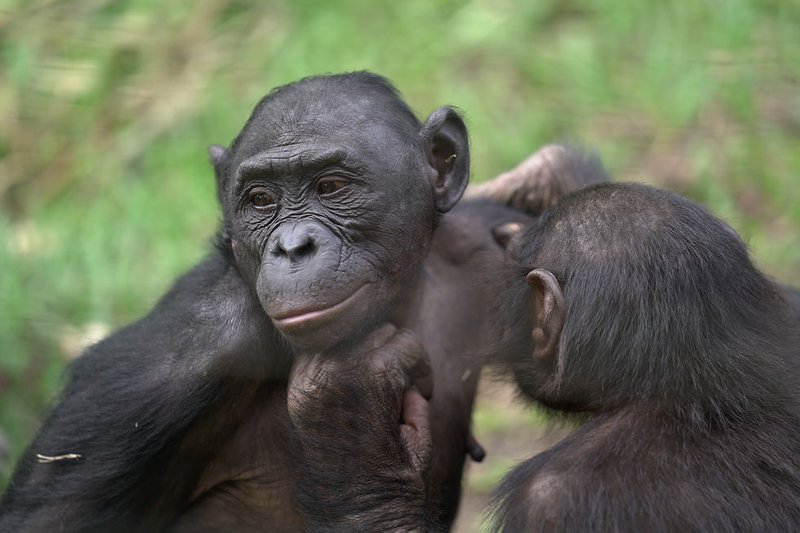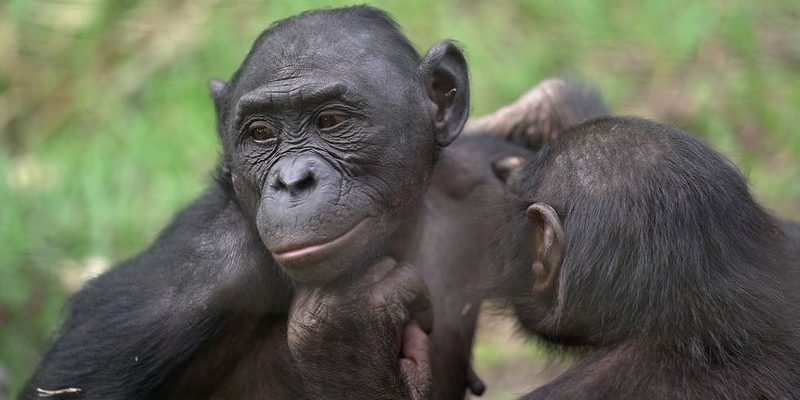
Bonobos are part of the great ape family and share about 98.7% of their DNA with humans. This close genetic relationship makes them a great subject for studying intelligence and behavior. So, how smart are bonobos really? Let’s explore their cognitive abilities, behavior, and what sets them apart from other primates.
Understanding Bonobo Intelligence
When we talk about bonobo intelligence, we’re not just measuring their ability to solve puzzles or use tools. It’s about their entire way of interacting with the world. Bonobos are known for their social skills and emotional intelligence. They communicate with each other using a mix of vocalizations, gestures, and facial expressions. Imagine them as experts in social networking, always aware of the dynamics within their groups.
Bonobos often engage in playful activities that not only strengthen their bonds but also showcase their intelligence. For instance, they might play games that require teamwork or strategizing, much like children might do at a playground. This playfulness isn’t just for fun; it’s crucial for their development and helps them learn about their social environment.
When comparing bonobo intelligence to that of other animals, it’s clear they possess unique cognitive traits. They excel in tasks that require empathy and cooperation, which sets them apart from other primates. You might be surprised to learn that bonobos often resolve conflicts through social bonding rather than aggression, highlighting their emotional intelligence.
Cognitive Abilities: The Basics
So, what are some specific cognitive abilities that showcase bonobos’ intelligence? For starters, bonobos can use tools in various ways. They have been observed using sticks to help extract termites from mounds or using leaves as sponges to soak up water. This tool use indicates not only problem-solving skills but also an understanding of cause and effect, much like how you might use a kitchen gadget to make cooking easier.
Bonobos also demonstrate impressive memory skills. Studies show they can remember where food is hidden and can even recall past events to cooperate successfully with others. This kind of memory allows them to navigate their environment effectively, finding food while avoiding dangers. Think of it as having a mental map that helps them strategize their next move.
Additionally, bonobos often learn from observing one another. This ability to pick up skills and behaviors from peers is a hallmark of intelligence. It’s similar to how we learn to cook or solve problems by watching others. So, when you see a bonobo figuring something out by watching another bonobo, you’re witnessing a little bit of genius in action.
Social Behavior and Intelligence
Social behavior is a significant aspect of bonobo intelligence. Their societies are matriarchal, meaning females often lead and maintain social bonds. This structure enhances cooperation and reduces conflict, which is essential for group survival. You might see bonobos comforting each other after a disagreement or playing together, reinforcing their social ties.
The way bonobos communicate also reflects their social intelligence. They can express a wide range of emotions, from joy to frustration, using complex vocalizations and physical gestures. This ability to communicate effectively ensures they can share information about food sources, potential threats, and even emotional states. Imagine having a conversation where you could convey not just words but feelings and intentions—this is how bonobos connect with one another.
Moreover, their social play is essential for learning. Young bonobos engage with older individuals, which helps them understand social cues and the dynamics of their group. It’s like attending a school where the lessons are taught through play and interaction. These experiences shape their understanding of their world and their place within it.
Problem-Solving Skills
Bonobos have shown impressive problem-solving skills in various studies. Whether it’s figuring out puzzles that require multiple steps or using tools creatively, they have a knack for thinking outside the box. For example, they can manipulate objects to achieve a goal, like retrieving a hidden treat in a maze. This ability not only highlights their intelligence but also their persistence; they often don’t give up easily.
There’s a famous study where bonobos successfully used a stick to reach a banana dangling just out of their grasp. This simple act demonstrated an understanding of not just the tool’s purpose but also spatial awareness and patience. Watching a bonobo in such situations can be enlightening—it’s like observing a mini-engineer at work.
Additionally, bonobos are known to engage in cooperative problem-solving. When faced with a challenge, they often work together rather than competing against each other. This teamwork is a testament to their social intelligence and can lead to successful outcomes that benefit the whole group. Just think about how collaborating with friends often leads to better solutions than tackling a problem alone.
Comparing Bonobos and Chimpanzees
When comparing bonobos to their close relatives, chimpanzees, there are some notable differences in intelligence and behavior. While both species are highly intelligent, bonobos tend to be more peaceful and exhibit more social cooperation. Chimpanzees can be more aggressive and competitive, particularly when it comes to acquiring resources.
In social settings, bonobos engage in more frequent social bonding activities, like grooming and playing. These actions enhance their group dynamics and overall intelligence. While chimpanzees also groom and play, their interactions often have a different tone, sometimes reflecting competition or dominance.
Both bonobos and chimpanzees use tools, but bonobos generally engage in more diverse tool use, such as using leaves for drinking. Chimpanzees might focus more on tools for hunting or gathering. So, while both species share intelligence traits, their social structures and behaviors highlight distinct paths of evolution.
Why Bonobo Intelligence Matters
Understanding bonobo intelligence is important for several reasons. First, it helps us learn more about our evolutionary history and the roots of human intelligence. Studying bonobos can provide insights into how social behaviors and cognitive skills have developed over time.
Second, bonobos play a crucial role in their ecosystems. Their intelligence helps them adapt to their environment and impacts the species around them. For example, their foraging habits can influence plant growth and the distribution of other species, reminding us of the interconnectedness of life.
Lastly, as bonobos face threats like habitat loss and poaching, understanding their intelligence can aid in conservation efforts. The more we learn about these amazing primates, the better we can work to protect them and their habitats. It’s essential to appreciate not just their intelligence but also their role in the larger picture of biodiversity.
In conclusion, bonobos are incredibly intelligent creatures that offer a window into the complexities of social behavior and cognitive abilities. From their problem-solving skills to their remarkable communication, they showcase a blend of intelligence that’s both fascinating and vital for understanding our world. Next time you hear about bonobos, remember that these extraordinary apes are not just our relatives; they are also brilliant beings in their own right.

